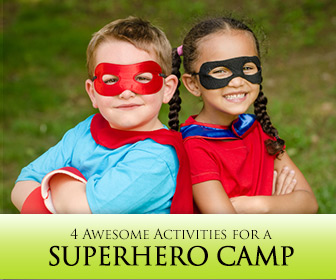
Planning an English immersion camp can be a very challenging undertaking, especially if you are dealing with some apathetic middle school students who would like nothing more than to be left alone for their vacation.
Although some teachers may be able to get their students really stoked about a week of grammar topics, I have never been one of them. Instead, I try to meet them halfway, engage with their interests, and spend camp working on fluency as much as anything else. One great way to do this is to design a superhero themed camp.
What with Hollywood pumping out a ton of superhero movies over the last several years, middle school students are really tuned into this particular topic. There are a plethora of ways to approach a superhero themed camp depending on the level of the students, the depth of the teacher’s own experience with superheroes, and the resources available to him or her. Try showing sections of the Avengers movie at the beginning of each day (of course you will show it in English). Avengers has the advantage of featuring several different superheroes, broadening the selection for the students to use as models. There are many potential activities centred on superheroes, but here are a few good options.

Try These 4 Activities for a Superhero Camp
-
1
New Twist on an Old Hero
Just like the constant updating of the Batman, Superman, or Hulk franchises, why not give your students a chance to remake an old superhero. Depending on your location, it may even be possible to locate a few older copies of the appropriate comic for the students to view. If not, most students have a pretty good idea of the history of their favourite superheroes. Ideally, split the class into groups of three to five. Try to ensure there is a high level student in each group, and, if possible, try to have an artistic/creative student in each group. Each group selects their superhero, preferably one that has not been featured in a movie in the last several years. They then write down the characteristics of this superhero based on the comics or movies. Once this task is complete, the teacher will explain to the students that they must recreate this superhero. Students can either add new physical and personality traits to the existing framework, or, start with just the concept (ie. a man associated with bats for batman) and rebuild them from the ground up. They must write sentences describing the changes they have made and illustrate the new superhero on a white sheet of paper or a poster using markers etc.
For this activity you will need markers, blank paper, and a sheet of lined paper. Depending on the level of your students, you may want to have prompts for characteristics available.
-
2
Heroes and Villains
Break the students into groups. Each group can choose if they want to create a villain (monster) or a hero. If there is an imbalance, have groups resolve it through drawing straws, playing rock, paper, scissors, or playing a warm-up game for points with first place getting to choose first, second place second and so on.
Groups must create a name for their character, an illustration of him in his full superhero outfit, a list of his gadgets, a list of his special power(s), a description of his various characteristics, and his secret identity. How much detail each teacher requires will depend on how much time they have and the students’ levels. Ideally, break the development up over several days. Start with the name and special powers. This will allow them to build the rest in a way that makes sense. For higher level classes, it can be helpful to regularly ask the students ‘why’ throughout the project. Why does your character have these powers? etc.
Students should develop the characteristics list and secret identity around the same time. Be sure to explain to the students that there should be some similarities between the hero/villain and the person who is their secret identity. Creating the gadgets can be an ongoing process as new ideas will certainly come to them throughout the creative process. The very last task should be to create an illustration of the character. This does not mean the teacher should discourage them from doing concept sketches as they will need some time to get a firm visual of their character. Have them illustrate the hero/villain on a large poster with the secret identity as a smaller section in the bottom corner.
This process can be done in several class periods or spread out over many days to meet the demands of the teacher’s schedule. Having said that, do not leave them too long with a single task or they will get bored and restless. Be sure to keep introducing new elements on a regular basis so that the students have new things to focus on.
As an extension, students can create an origin story for their hero/villain, a fictional world/city for them to inhabit, and the ideal partner for their character.
-
3
Create Your Own Super Hero Comic
This can be a great follow up to the above project because the students will have already created the characters they need in their comic. Alternatively, teachers can encourage students to use heroes/villains from existing comics and just create a new storyline.
Depending on the number of students in a given camp, it is possible to develop comic books either in groups or as an entire class. There are several parts to this. You can start with either character or plot development. Superhero comics tend to have a pretty standard story arc so the students really only need to fill in the details. Set parameters for the story (it must have a hero and a villain, it must have at least five characters, etc.) and then explain that general points of a good story plot (introduction, rising action, climax, and resolution). Lower level classes will struggle with this in English, so teachers can simply turn them loose and see what results or make sure you have time (and maybe translation) to ensure that students fully understand what they need to do. Teachers can use a version of the above activity for character development.
Supply them with papers that have comic book style frames in different configurations so they have some selection. Beyond setting a rough page goal, it’s probably best to leave as much of the creative process up to the students as possible. To get the creative juices flowing, show them some clips from super hero movies, or have a few comic books available for them to browse. Once things are moving along, teachers should be able to sit back and watch the creative process happen.
-
4
What Would Superman Do?
This is a great warm-up activity to get the students thinking about superheroes and what makes them great. Create a set of situations. Some of these should be fantastic and others related to the students own interests and lives (if possible). Divide the students into groups and explain that a situation will be presented and they must ask themselves ‘what would Superman do?’ to try and come up with the most honourable and effective way to fix the problem. Whichever group is best able to balance these two things gets a point for that situation.
When you’re talking about superheroes, there are tons of activities that students will enjoy, especially if you mix in a liberal sprinkling of superhero movie clips.
Students really just need something to hold their interest, so, as long as you are getting them involved in something other than endless grammar worksheets, you’re off to a good start. Mix in a little hero time and let the good times roll!
P.S. If you enjoyed this article, please help spread it by clicking one of those sharing buttons below. And if you are interested in more, you should follow our Facebook page where we share more about creative, non-boring ways to teach English.







